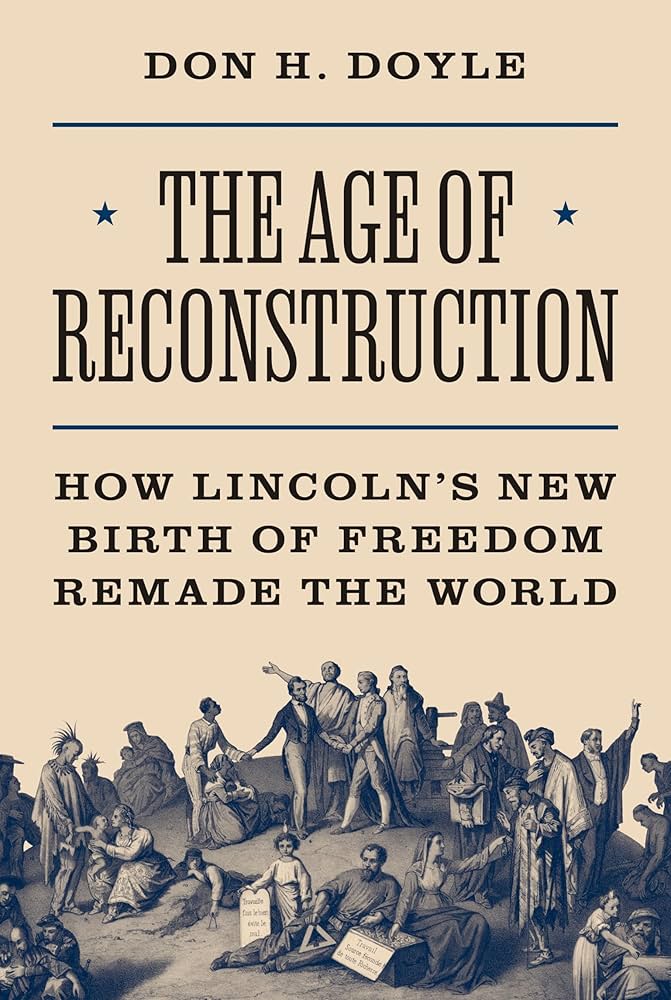Book Review: The Age of Reconstruction: How Lincoln’s New Birth of Freedom Remade the World
The Age of Reconstruction: How Lincoln’s New Birth of Freedom Remade the World. By Don H. Doyle. Princeton University Press, 2024. Hardcover, 369 pp. $35.00.
Reviewed by Rich Condon
The Reconstruction Era has historically been treated as a sidebar to the Civil War, or an afterthought of the sectional conflict that began well before the first shots were fired on United States troops stationed at Fort Sumter. In recent years, however, new scholarship has begun turning over old stones, under which previously unexplored aspects of the post-war period have presented new perspectives on our national, and at times international, conflict.
Don H. Doyle’s The Age of Reconstruction: How Lincoln’s New Birth of Freedom Remade the World not only presents readers with a fresh look at the global effects of the American Civil War, but assesses the remaking of a young nation in the wake of slavery’s destruction. In his latest work, Doyle, professor emeritus of history at the University of South Carolina, explores a largely understudied aspect of Reconstruction while working to bridge a historiographical gap focused on foreign relations during the post-Civil War period. There are a multitude of ways through which Doyle has sought to accomplish this task.
Following the assassination of President Abraham Lincoln, for example, citizens around the world mourned his loss as if it were their own, often in spite of reigning monarchial powers. Lincoln, viewed as a symbol of emancipation and republicanism, came to embody the hopes of those who sought true freedom just as the United States served as a beacon of hope for a struggling country’s democratic potential. As Doyle asserts, “Lincoln rose in death a global hero and martyr to the cause of human freedom, equality, and government by the people. It was a rare moment of shared emotions.” (15) According to Doyle, he became “the unimpeachable embodiment of government elected by the common people and the prophet of world democracy.” (16)
Lincoln’s death serves as just one of the many tools Doyle employs to explore the breadth of American influence during the Reconstruction era. Through a myriad of immediate post-war developments, such as the re-assertion of the Monroe Doctrine in North America to Brazil’s abolitionist factions calling for the eradication of slavery in the name of Lincoln, or the immediate post-war dealings with Napoleon III along the Mexican border, Doyle asserts the role of the United States in the development of democratic ideals beyond the battlefield. As the United States endeavored for a reunited nation and a death blow to the slave power, Doyle further posits that the “American Civil War was part of the contest between monarchy and republicanism, aristocracy and democratic self-rule, and slavery and freedom.” (53)
In a larger sense, Doyle’s treatment of the far-reaching arm of Reconstruction allows readers to better understand foreign interpretations of America’s conflicts, shortcomings, and sources of inspiration on the world stage. This, of course, includes the dismantling and defeat of Reconstruction on American soil by factions of white supremacists and imperialist supporters; what Doyle refers to as “the antitheses of liberty and equality.” (296) While we’re often tempted to view the Civil War and Reconstruction in a domestic vacuum, a far-flung perspective of democratic ideals provides the opportunity to not only recognize the progress of American-influenced republicanism abroad, but its development, and downfall, right at home. Doyle’s treatment of Reconstruction beyond the American border is therefore appropriate for any student or historian seeking to better understand the nuanced nature of international policy in a post-emancipation society.
Rich Condon is a public historian from Pittsburgh, Pennsylvania, and a graduate of West Virginia’s Shepherd University. For over a decade he has worked with a multitude of sites and organizations including The Battle of Franklin Trust, the National Museum of Civil War Medicine, Soldiers & Sailors Memorial Hall and Museum, and the National Park Service, including work at Beaufort, South Carolina’s Reconstruction Era National Historical Park and Catoctin Mountain Park. He has written for Civil War Times Magazine, The American Battlefield Trust, as well as Emerging Civil War, and operates the Civil War Pittsburgh blog, which focuses on sharing stories related to western Pennsylvania’s role in the Civil War. Rich currently lives in Gettysburg.


I’ve been interested in the post-CW history of US foreign policy with East Asia such as Korea and the 1871 Battle of Gangwha. From what I’ve seen Grant biographers don’t spend much time investigating foreign policy, but maybe I just haven’t had the right sources. I live in Hawaii and the post-CW period was critical in Hawaii history preceding the overthrow of the Monarchy.
I pray that Doyle interjected a word of caution that the saintly aura surrounding Lincoln, and a rebirth of freedom around the world only arose at the end of the 20th/beginning of the 21st century. This is not a knock on Lincoln – I admire him greatly. But Lincoln as the God-sent civil rights leader never existed in his time, or well after it. That is a product of latter-day historians struggling desperately to rationalize the Civil War into what they want it to be.